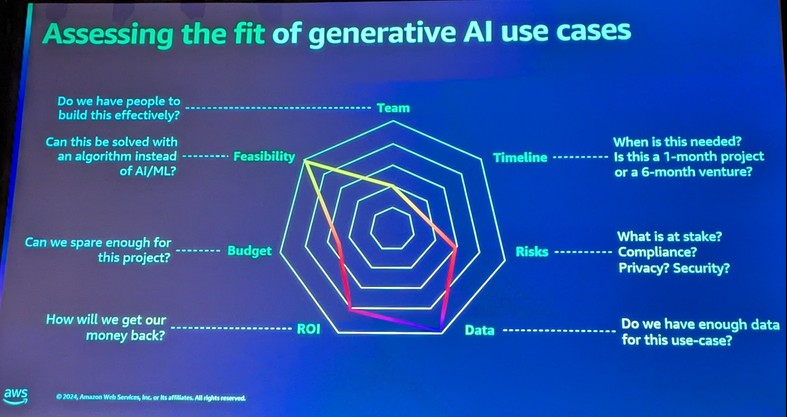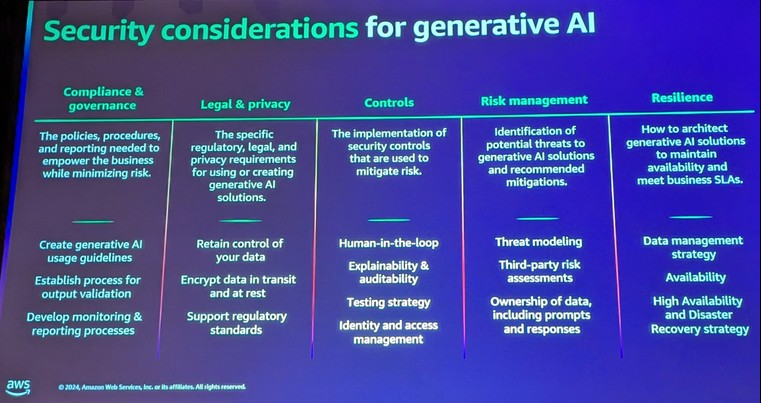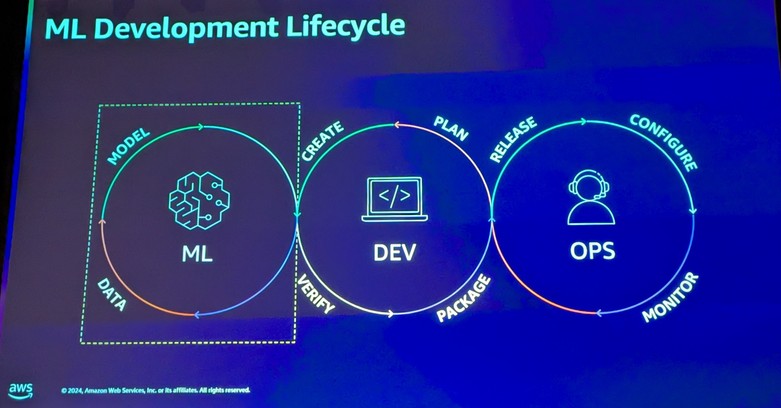Proof-of-Concept to Production: How Amazon Scales with GenAI (AMZ302)
Neal Gamradt
Monday, January 20, 2025
Amazon Web Services
AWS
AWS Cloud
Cloud Conference
Conference
Session
AMZ302
reInvent
reInvent 2024
re:Invent
re:Invent 2024
Updated: Tuesday, January 21, 2025
At re:Invent 2024, I attended many different sessions. In this post I will summarize what I learned in the “Proof of Concept to Production: How Amazon Scales with GenAI” session.
Table of Contents
Overview
This session (AMZ302) discussed how Amazon scales its AI solutions, particularly focusing on the transition from proof-of-concept to production.
This sessions was presented by:
- James Park: Principal ML Solutions Architect at AWS
- Burak Gozluku: Principal ML Solutions Architect at AWS
Details
Below is a useful slide which outlines factors you should consider when assessing the fit of generative AI for different use cases:
 Assessing the fit of generative AI use cases
Assessing the fit of generative AI use cases
The following are the main points that I took away from this session:
- Amazon's Use of AI:
- Challenges in AI Implementation:
- Key challenges include dealing with hallucinations, ensuring low latency, maintaining security (jailbreaking), and producing unbiased, cost-effective batch processing of review summaries.
- Experimentation is crucial for AI product development, involving thousands of tests to meet accuracy standards.
- There are many security considerations to take into account, as outlined in the following slide:
 Security considerations for generative AI
Security considerations for generative AI
- Experimentation and Model Selection:
- Choosing the correct model is difficult and requires extensive experimentation.
- Amazon uses multiple models that may communicate with each other before responding, and they budget for the experimentation time needed to get the current version correct.
- Off-the-shelf models are commonly used, with a focus on prompt engineering.
- Iterative Improvement and Customer Feedback:
- Iterative improvement and customer feedback are essential for refining AI models.
- Public benchmarks are insufficient; actual user feedback and anecdotal information are critical for monitoring and enhancing the product.
- Your first release is probably not going to be great and will have to improve over time.
 ML Development Lifecycle
ML Development Lifecycle
- Cost and Efficiency:
- Speed, cost, and latency are important factors in AI implementation.
- Bedrock flows can be a cost-effective way to improve accuracy.
- Human-in-the-loop is important for better accuracy, and having multiple small LLMs might be more efficient.
- Practical Considerations:
- Some decisions should be made at the vector database level before reaching out to the LLM.
- It's important to start small, focusing on specific use cases like customer support, and then expand from there.
- Filtering out toxic responses is important and can be done with the help of other AWS services. For example, Amazon Ads uses Amazon Comprehend to filter out toxic responses.
- Monitoring and Metrics:
- A good framework to monitor the product is essential, and measuring the revenue impact of the chatbot is important.
- Bedrock has parsing patterns that allow for this kind of monitoring.
Conclusion
I am just getting started with the implementation of GenAI solutions; this session was really interesting and the insights provided are really valuable to a newbie like me. I am really happy that I was able to attend this session.
If you enjoyed this post, you may want to read about my thoughts on the re:Invent 2024 keynotes.
 Assessing the fit of generative AI use cases
Assessing the fit of generative AI use cases Security considerations for generative AI
Security considerations for generative AI